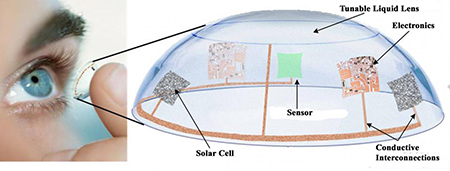
Many of the components for the contact lens—the sensors, electronics, solar cells—will be embedded along the edge of a flexible material. Credit: Hongrui Jiang [Enlarge image]
Inspired by the scotopic visual system of elephantnose fish, scientists from the University of Wisconsin-Madison, USA, have designed and demonstrated a highly photosensitive artificial eye with a lens that can autofocus without bulky electronic image sensors and power sources (Proc. Nat. Acad. Sci. USA, doi: 10.1073/pnas.1517953113). The authors say that their work could lead to a contact lens that would benefit people with presbyopia, who often also have a hard time seeing in low-light conditions, and inspire photosensitive imaging systems for a variety of applications.
Elephantnose fish retinas are lined with cup-shaped structures with reflective sidewalls that gather and magnify light, making the most of their low-light environment so that the animal can spot and evade predators. Jiang and his colleagues mimicked the elephantnose fish’s retinas with a flexible lens design that includes an array of finger-like glass microphotocollectors (µ-PCs) lined with reflective aluminum. The lens also contains algorithm-driven sensors, electronic circuits and a solar-cell power source to complete the imaging system.
The researchers tested a 48 x 48 array of their µ-PCs on a mechanical eye model in the lab. The array improved light intensity by a factor of 3.8 and imaging tests showed that the array also enabled recognition of letters and complex images under low-light conditions.
The authors say that a contact lens based on their artificial eye design is 5 to 10 years away from clinical testing, but, says Jiang, “once it’s available, it may not cost much more than a conventional contact lens” to make because the nearly one billion people with presbyopia would drive mass-production. They also propose that their design may prove useful in low-distortion night-vision cameras, endoscopes, robotics, and space exploration.
